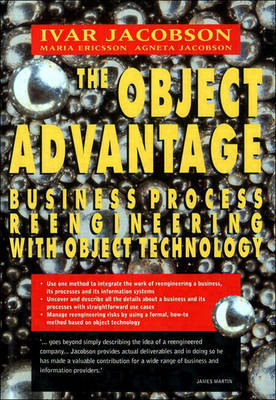
The Object Advantage
Addison-Wesley Professional (Verlag)
978-0-201-42289-4 (ISBN)
- Titel ist leider vergriffen;
keine Neuauflage - Artikel merken
Business Process Reengineering (BPR) is the key management trend of the day. Ivar Jacobson's book The Object Advantage presents a blueprint for re-designing a business according to BPR principles. It uses one method to integrate his work of reengineering a business, its processes and its vital infrastructure the information system. It describes all of the details about a business and its processes by viewing customers as users and business processes as cases of how they use the business "use cases". And it manages the risks involved in BPR by using a how-to method based on object technology, offering concrete guidance in the shape of a formal reengineering process.
Whilst most books tackle the "soft factors" (motivation, management commitment, leadership), The Object Advantage goes beyond this type of hand-waving and offers practical steps to success that include: * A description that specifies every activity and deliverable involved in the business process * Deliverables, in the form of business models, that focus on the company's architecture and dynamics * A process for the development of an information system that is truly integral to the reengineered company A seamless relationship is created between business model and information system, vastly increasing a company's chances of successfully reenginneering itself - the heart of this relationship is the application of the BPR model and object technology. Ivar Jacobson's book will be essential reading for any manager contemplating reengineering their business or wishing to understand more about BPR and its practical implementation.
It will also be invaluable for reenginnering teams re-designing their companies, employees within a reengineered company needing to understand how their new environment will work and what their role will be, and systems analysts and designers wanting to expand their current applications of object technology into business modelling and business reengineering.
Foreword by James Martin Foreword by Dan L. Jonson Preface 1: Business engineering * Introduction * What is business engineering? * Why do we need business engineering? * What does the new company look like? * Business engineering, business (process) reengineering, and business improvement * Risk management * The future of business engineering in the corporate world * Summary * References 2: What is business modelling? * Introduction * What is a model? * What is a business model? * What does a business model look like? * A few words about the traditional way of modelling * Why do we need business modelling? * Who should have a business model, and why? * Working to develop a business model * Summary * References 3: What is object orientation? * Introduction * Object-oriented models * What is an object? * Objects are linked * Objects can form from aggregates * Objects belong to a class * One class can inherit other classes * A summary * Why is object orientation necessary? * Object orientation as a platform for the future * Object-oriented business modelling * Summary * References 4: Object-oriented business engineering - an overview * Introduction * Object-oriented business engineering in context * Business reengineering overview * The reengineering directive * Envisioning * The objective specification * Reversing the existing business * Engineering the new business * Installing the new process * Iteration * Business Improvement * Summary * References 5: Architecture * Introduction * What must you be able to express in a business model? * Internal and external models of business * The use-case model * The object model * Use case versus objects * Associations between use cases * More about use cases * Subsystems * Summary * References 6: Reversing the existing business * Introduction * Why reverse engineering? * Overview * Building a use-case model * Building an object model * Analyzing the result * Summary * References 7: Forward business engineering * Introduction * Building a use-case model * Object modeling * Interaction diagrams * Information system development * Verifying the new business * Summary * References 8: An example * Introduction * What do we want to change * What kind of organization do we have now? * New business processes * An object model of the new business * Work-flow descriptions * Summary * References 9: Building the supporting information system * Introduction * What is software development? * The software-development business-system objects * System development and business development * Procuring the new information-system support * Summary * References 10: Managing object-oriented business engineering * Introduction * Tailoring the method * Project organization and management * Project staffing * Organization staffing * Reviews * Summary * References 11: Scaling up to large businesses * Introduction * Two use-case models at different abstraction levels * Business system areas * Layered business models * Summary Glossary Index
| Reihe/Serie | ACM Press |
|---|---|
| Sprache | englisch |
| Maße | 165 x 244 mm |
| Gewicht | 794 g |
| Themenwelt | Informatik ► Software Entwicklung ► Objektorientierung |
| Wirtschaft ► Betriebswirtschaft / Management ► Unternehmensführung / Management | |
| ISBN-10 | 0-201-42289-1 / 0201422891 |
| ISBN-13 | 978-0-201-42289-4 / 9780201422894 |
| Zustand | Neuware |
| Haben Sie eine Frage zum Produkt? |
aus dem Bereich


